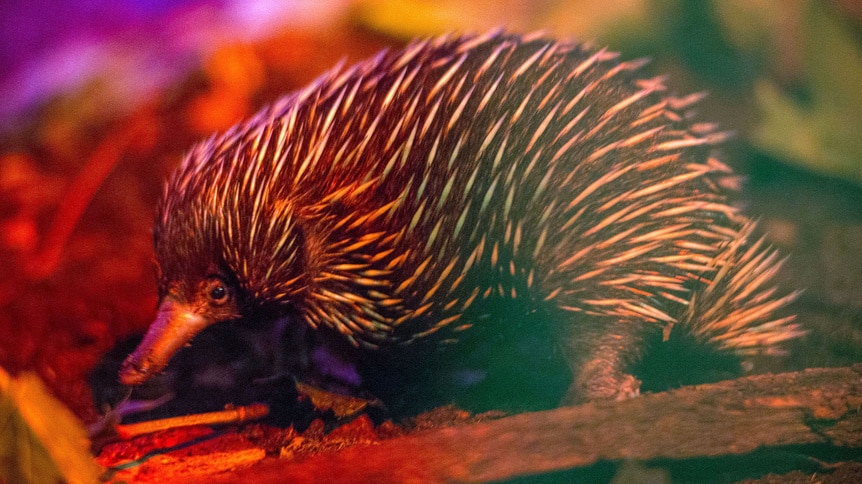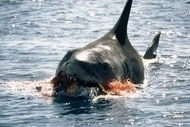Create a free profile to get unlimited access to exclusive videos, sweepstakes, and more!
Tiger Shark Vomits Up Intact Echidna in Bizarre Shark Attack
Researchers off the coast of Australia observed a tiger shark spitting up an echidna, a small, spiny land mammal.

In May 2022, a team of researchers from James Cook University were catching and tagging marine animals near Orpheus Island, off the coast of Queensland, Australia. The effort was part of the Queensland Integrated Marine Observing System Acoustic Telemetry Array Project, which uses acoustic and satellite trackers to observe the health and movements of animal populations over time.
They captured a tiger shark and discovered the weirdest predatory crossover of sharks and land animals since SYFY’s own Sharknado. As soon as it was captured, the tiger shark vomited up an echidna, intact with all four limbs and spines. You might imagine that echidnas aren’t usually on the menu for tiger sharks, what with them being tiny land mammals, and this shark probably won’t be going back for seconds.
“When it spat it out, I looked at it and remarked, ‘What the hell is that?’" said Dr. Nicholas Lubitz, in a statement.
The fact that it was intact suggests it was swallowed whole and recently consumed. Researchers suspect the animal’s spiny exterior was irritating to the shark’s throat and the predator opted to toss its prey back.
For More on Sharks:
How Baby Hammerheads Grow Their Weird Tool-Shaped Heads
Longest-Living Vertebrate Ever? Greenland Shark Thought to Be 393 Years Old, Give or Take a Century
A South African Killer Whale Took on a Great White Shark One-on-One and Won
After Being Attacked by a Tiger Shark, Echidnas Just Keep Getting Weirder
Being eaten by a shark isn’t even close to the weirdest thing about echidnas. They’re bizarre little critters who, along with the platypus, are the only living egg-laying mammals. They are covered in spines, modified hairs made of keratin, similar to those found on porcupines and hedgehogs. Their name might come from a half-human, half-snake creature from Greek mythology, owing to its strange mix of features. It might also come from the Greek word “ekhinos,” meaning hedgehog or urchin.
They eat mostly ants and termites, earning them the nickname “spiny anteater,” though they aren’t closely related. They eat by flicking their long tongue out of an elongated toothless snout covered in electrosensors. Those sensors help them seek out subterranean creepy crawlies to grub on. They are adapted for digging through dirt with their long claws, and typically hang out in forests or woodlands, hiding under vegetation, in caves or rocky crevices, trying to beat the heat.
After mating, a female echidna spends 22 days producing an egg, which it lays directly into its pouch. The baby echidna, called a puggle, opens the egg with an egg tooth about 10 days later and begins nursing from a pair of milk patches where their nipples should be. Puggles stay in the pouch for about 50 days before moving into a nursery burrow, where they live and nurse every few days for the next seven months. It doesn’t sound like the sort of life that lends itself to run-ins with tiger sharks, but here we are.
Echidna Swallowed Whole by Tiger Shark
Great white sharks get all of the headlines and most of the blockbuster movies, but tiger sharks are fearsome fish, willing and able to eat just about anything. They take their name from the dark stripes trailing along their bodies, which fade as they age.
They take second place to white sharks in the number of attacks on humans, but it isn’t personal. Tiger sharks have the widest diet of all known sharks, and that diet extends beyond the edible. Researchers often find bits of metal and other garbage stuck in their stomachs. If they can get their mouth around it, they’ll swallow it. Enter: the echidna.
While echidnas prefer comfortable burrows and forest underbrush, they are also excellent swimmers. They swim to cool off or to clean themselves, but also for fun, according to Peggy Rismiller, director of the Pelican Lagoon Research and Wildlife Center, via Australian Geographic. Rismiller has received several reports of people attempting to “rescue” echidnas from the water only for them to dive right back in.
Researchers suspect the echidna was swimming in the shallows or traveling between Orpheus and nearby islands when the tiger shark saw its chance for a snack. Unfortunately, it ended up being wasted calories. The shark was fitted with a tracker and released unharmed. Already it has provided new scientific insight into the behavior of both tiger sharks and echidnas, and it should continue to provide information about the nearby ecosystem for years to come.
Catch Sharknado: Heart of Sharkness streaming now on Peacock.




























